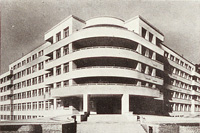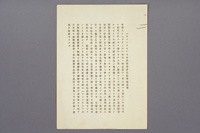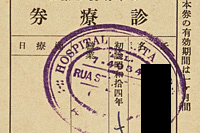Dojinkai Corporation of Japanese residing in Brazil and Nihon Hospital
In Japanese settlements epidemics of infectious diseases such as malaria, hookworm, trachoma, amebic dysentery and tuberculosis often broke out. Although a Japanese doctor was stationed in settlements managed by a company such as the Kaigai Kogyo Kabushiki Gaisha (Overseas Enterprise Company Limited) and Brataku, there was no doctor in most Japanese settlements.
Since there were a few doctors in rural districts in the State of São Paulo in the prewar period, doctor home visit fees were extraordinary expensive. Many Japanese immigrants had to give up consulting a doctor, and not a few immigrants were, even if they consulted a doctor fortunately, not be able to receive proper medical treatment due to a language barrier between the immigrant and the Brazilian doctor and consequently lost their lives needlessly. The placement of a Japanese doctor was constantly requested from immigrants.
Creation of the Dojinkai Corporation
With a rapid increase in the number of emigrants in the late Taisho era (1912-1926), the doctor problem was considered to be one of the problems that the Japanese Government shoud solve. Japanese doctors were not legally permitted to practice medicine without a Brazilian doctor’s license, although in outlying regions, where there were no doctors, some Japanese doctors were tacitly permitted. The Japanese Government sent four students to obtain a Brazilian doctor license at the University of Rio de Janeiro, School of Medicine in 1923. Simultaneously, the Government also provided 36,000 yen to immigrants as financial assistance for health care, which was used by the Consulate General of Japan in São Paulo for the creation of the Dojinkai Medical Health Corporation of Japanese residing in Brazil. Japanese people residing in São Paulo City had already had a plan to construct a Japanese hospital before the creation of the Dojinkai Corporation and the Dojinkai Corporation itself was actually created for this purpose.
But since the Dojinkai Corporation was created after consulting with influential members residing in Sau Paulo City alone of the Japanese community, pioneers of immigration in outlying regions of the Noroeste line, including Shuhei Uetsuka and Teijiro Suzuki, felt disagreeable, and began a campaign for the construction of the Noroeste Hospital. The campaign was brought to a halt due to the major drought in 1927. Finally a plan to build a large hospital in the City of São Paulo was adopted through the mediation of the Consul General at São Paulo.
-
 The São Paulo Japanese Hospital, of which the construction was started in August 1936 and completed April 1939
The São Paulo Japanese Hospital, of which the construction was started in August 1936 and completed April 1939 -
Articles in newspapers / magazines
Immigrants in outlying regions rebel against the establishment of the Dojinkai Coporation
Campaign for the construction of a Japanese hospital
The Dojinkai Corporation made efforts to improve medical environment in rural areas. It not only set up local clinics under its direct control in Bauru and Lins in August 1930, and in Santos and Presidente Prudente in July 1932, but began to coordinate medical caravans.
A building lot for the new hospital was obtained in the Vila Mariana district as early as 1926, but no progress was made afterwards. In 1931, Iwataro Uchiyama (Governor of Kanagawa Prefecture in 1947-1967) became the Consul General, and formed the "League for the Constrution of São Paulo Japanese Hospital" which began fundraising in the Japanese community and then the campaign for the construction of the hospital started in earnest.
In 1934, the Imperial House made a donation of 50,000 yen for the construction of the hospital. It made the campaign gather the momentum. In March 1935, the Committee on the Construction of the São Paulo Japanese Hospital was established, which was made up of influential members of the Japanese community in Brazil. It was decided that the construction cost should be 800,000 yen and that among the cost, 250,000 yen should be provided by the Japanese Government as financial aid, 400,000 yen raised in Japan and 100,000 yen raised from Japanese residing in Brazil. The "Association for the Patronage of the São Paulo Japanese Hospital Construction" (chaired by former Prime Minister Minoru Saito) was established in Japan through the mediation of the Ministry of Foreign Affairs in August 1935, and the fundraising commenced in Japan.
Inauguration of the Japanese Hospital
The construction of the hospital building was started in August 1936, and completed in April 1939. The hospital began its operation soon after the completion. The construction cost of the hospital increased to 4,979 contos (about 1,000,000 yen). The hospital officially called "Sociedade Brasileira e Japonesa de Beneficência Santa Cruz Hospital (the Japan and Brazil Charitable Society Santa Cruz Hospital), was a general hospital with 76 patient rooms and 200 beds, the building of which was the largest of Japanese-owned ones overseas in the prewar period, with an area of 1,460 m2 and had five floors above ground and one floor below ground. After the severing of diplomatic relations between Brazil and Japan with the outbreak of the Pacific War in 1942, the hospital was seized as enemy assets and the Japanese Hospital management right were transferred to a non-Japanese. The right had not returned to a Japanese for a long time since then, however finally returned to a Japanese in February 1990 as a result of years-long efforts by the Japanese community.
-
 Fundraising in Japan
Fundraising in Japan -
Articles in newspapers / magazines
-
 Patient registration card of Japanese Hospital
Patient registration card of Japanese Hospital










